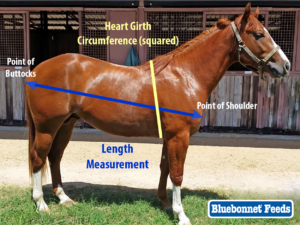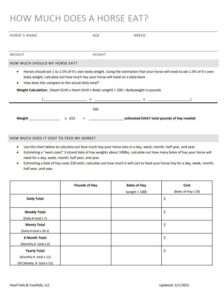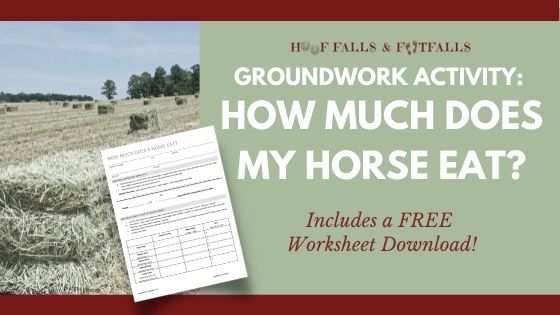Learning how much a horse eats (and how much it costs to feed them) can be a fun and educational activity!
This is one of my go-to worksheets when a student is unable to ride due various reasons. This worksheet can be incorporated in both traditional and adaptive lessons as well as in private, semi-private, or group formats.
Learning how much a horse eats and how much it costs to feed a horse is a fun way to practice educational skills like unit conversion, multiplication, division, estimation, comparing/contrasting, and more!
- What you will need:
- Printed worksheet (PDF WORD)
- Clipboard
- Pencil
- Measuring tape (or equine weight tape)
- Calculator
- Optional: Small zip lock snack bags
Building a lesson around the worksheet
Step #1 Measure & Weigh
Start in the barn and let the student choose a horse to “weigh”. Most of my students choose the horse they usually ride but some may chose the smallest or largest equine in the barn.
Before we begin, I will show the students an image of where we will be measuring so they can see what we will be doing with the measuring tape and their horse. 
Assist your student in measuring their horse’s heart girth and length and/or have them work in teams to measure. This is a great time to review body parts!
If you are using a regular measuring tape you may want to tell your students that you will be converting the measurement from inches and feet to only inches.
Step #2 Understanding Bales & Flakes
Once you get the necessary measurements from the horse(s), show the students what a bale and a flake are as these are common equine terms but may be new or forgotten by your students. Point out on the worksheet where the “bale” terminology will come into play.
NOTE: You may need to edit the worksheet download to reflect the size and weight of your bales, average cost, etc.
TIP #1 Enhance the lesson: Have the student(s) put samples of the different hay types in the zip lock snack bags. You can have them feel, touch, and discuss these later if you need a time filler.
Tip #2/Enhance the lesson: While looking at the bales, have your students guess how much their horse eats in a week. You can compare their guess to the actual results later.
Step #3 Calculations & Completing the Worksheet
Have the students start filling in the worksheet by starting with their horse’s name, age, color, and breed (a great way to review or introduce colors and breeds!).
You may need to assist or prompt the students to convert the feet and inches measurements of the length and heart girth to inches only when calculating the horse’s weight OR you can use an online horse weight calculator.
Help students work their way through the worksheet with appropriate assistance. Even if students are not doing multiplication and division yet in school, they can still put numbers in the calculator which is a great way to practice number and math symbol recognition.
Tip: If you are running out of time or you are loosing the attention of the students, have them only a select few things on the bottom chart (like day, month, and yearly feed and cost)
Bonus things to incorporate and enhance your lesson:
- Have students compare/contrast how much each one of their horses eat.
- Have students guess the weight of each others horses by comparing their peer’s horse to their own horse.
- Compare and contrast how much the largest and smallest horses (or ponies) in your barn weigh and eat.
- Add up the daily cost of each student’s horse to find out how much it would cost to feed all the horses for one day (or week…or year!)
- Have students draw out a stack of hay on a whiteboard or piece of paper demonstrating how many bales of hay their horse eats in a month, half year, and year.
Teach this to more than just your students….
This worksheet can also be used to create a fun and educational volunteer training that will help enhance their knowledge of equines and deepen their understanding about the costs associated with owning a horse and/or running a lesson program. Educational opportunities like this can be a great “thank you” opportunity for volunteers where they get a valuable learning experience.
Get your FREE "How Much Does a Horse Eat?" worksheet!
NOTE: You will likely need to edit the worksheet download to reflect the size and weight of your bales, average local cost per bale, etc.

*This page contains Amazon Affiliate Links. I earn a small commission off any products purchased through my affiliate links. This commission goes right back into HF&F to help offset the time, money, and resources it takes to creating free and low-cost EAS Industry Instructor education! Thank you for your purchases though my links!
 Check out IntuitiveInstructorClub.com to access online education from multiple EAS industry professionals! (OVER 110 videos currently available at the time of publishing this blog!) This is a great way to knock out CEUs and grow as an instructor!
Check out IntuitiveInstructorClub.com to access online education from multiple EAS industry professionals! (OVER 110 videos currently available at the time of publishing this blog!) This is a great way to knock out CEUs and grow as an instructor!

